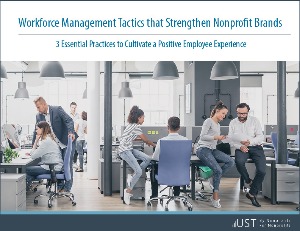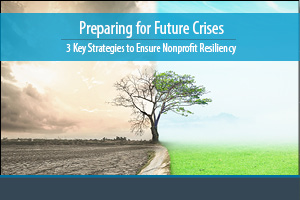
One of the biggest challenges nonprofits are faced with is the “great resignation” sparked by the pandemic—where employees are burnt out and pursuing new jobs that better align with their evolving priorities. In order to stay competitive in today’s job market, nonprofit leaders must reinvent their recruitment tactics, work-life balance initiatives and employee engagement strategies.
Don’t miss your chance to download a free copy of UST’s latest eBook, Workforce Management Tactics that Strengthen Nonprofit Brands, to discover 3 key strategies that can help your nonprofit create (and sustain) a resilient workforce.
In this eBook, you’ll discover:
This eBook will help you uncover new strategies that will encourage your current (and future) workforce to carry out your mission for years to come.

Question: Do OSHA’s regulations and standards apply to the home office? Are there any other federal laws employers need to consider when employees work from home?
Answer: The Department of Labor’s Occupational Safety and Health Administration (OSHA) does not have any regulations regarding telework in home offices. The agency issued a directive in February 2000 stating that the agency will not conduct inspections of employees’ home offices, will not hold employers liable for employees’ home offices, and does not expect employers to inspect the home offices of their employees.
If OSHA receives a complaint about a home office, the complainant will be advised of OSHA’s policy. If an employee makes a specific request, OSHA may informally let employers know of complaints about home office conditions but will not follow-up with the employer or employee.
Employers who are required to keep records of work-related injuries and illnesses will continue to be responsible for keeping such records for injuries and illnesses occurring in a home office.
The Fair Labor Standards Act (FLSA) and its implementing regulations do not prevent employers from implementing telework or other flexible work arrangements allowing employees to work from home. Employers would still be required to maintain an accurate record of hours worked for all employees, including those participating in telework or other flexible work arrangements; and to pay no less than the minimum wage for all hours worked and to pay at least one and one-half times the employee’s regular rate of pay for all hours worked over 40 in a workweek to nonexempt employees.
Employers are encouraged to work with their employees to establish hours of work for employees who telework and a mechanism for recording each teleworking employee’s hours of work. Nonexempt employees must receive the required minimum wage and overtime pay free and clear. This means that when a covered employee is required to provide the tools and equipment (e.g., computer, Internet connection, facsimile machine, etc.) needed for telework, the cost of providing the tools and equipment may not reduce the employee’s pay below that required by the FLSA.
Under the Americans with Disabilities Act (ADA), telework could be a reasonable accommodation the employer would need to provide to a qualified individual with a disability, barring any undue hardship. However, an employer may instead offer alternative accommodations as long as they would be effective.
Q&A provided by Mineral, powering the UST HR Workplace for nonprofit HR teams. Have HR questions? Sign your nonprofit up for a free 60-day trial here.

Turnover is a natural part of any nonprofit organization’s life cycle, and employee offboarding should be handled with the same degree of importance as onboarding a new employee. An offboarding plan offers an opportunity for communication and manage change, to help preserve and improve your employer brand and to generate good faith with the departing employee. There can be many moving pieces involved with a termed employee and clear offboarding procedures help manage the expectations of all parties involved.
When done correctly, the employee offboarding process can offer key management insights and reveal hidden internal issues. From a management point of view, the focus is to address issues at an organization level. Whereas, employees are faced with small issues that aren’t always noticed by managers or the executive team. Not giving attention and time to these small and recurring issues can lead to larger issues which could then impact the productivity of the organization.
Here are some best practices when creating an efficient and smooth employee offboarding process:
1) Learn why the employee is leaving: Maybe the employee wasn’t a long-term fit for your company culture, perhaps they came across a career-changing opportunity, or they weren’t a fit to handle growth gracefully. Regardless of the reason, organizations need to first understand the reason why an employee wants to leave and have a clear plan in place to handle each type of exit. Having the appropriate policies and procedures in place to handle any and all offboarding reasons are key for orchestrating a smooth departure.
2) Conduct a smooth offboarding: A crucial aspect of a good employee offboarding process is to treat employees warmly, regardless of the reason behind their departure. Creating a positive farewell will encourage employees to speak to others positively about their experience which in turn, increases the organization’s brand value. Taking the opportunity to engage departed employees will help with talent acquisition and managing the reputation of the organization’s brand.
3) Ask for feedback: When an employee leaves, it can be a valuable opportunity to collect insightful turnover data. During the exit interview, the employee can offer honest feedback about the organization since they are no longer reliant on this job for financial means. When an employee expresses their desire to leave, sending them an exit interview survey can help organizations uncover areas of opportunities that need to be addressed to improve employee engagement and productivity.
4) Avoid decreases in productivity: When an employee departs, day-to-day activities overseen by this employee will be interrupted or possibly put on pause—resulting in a decrease in productivity. Cross training with current employees can prevent a dip in productivity, such as, transferring process knowledge, document procedures and responsibilities, and login credentials for business tools.
Depending on the reason for the employee’s departure, exit interviews are an opportunity to collect important insights to improve your current offboarding strategy. The complexities involved in offboarding make saying “goodbye” to employees a challenging task—which is why consistency is the key to a successful exit interview. With the right tools in place, organizations have the ability to standardize the complexities involved in employee offboarding and help you part ways in the most efficient way.

Question: As we begin to return to work, if an employee is out of the office due to sickness, can we ask them about their symptoms?
Answer:Yes, but there’s a right way to do it and a wrong way to do it. In non-pandemic circumstances, employers shouldn’t ask about an employee’s symptoms, as that could be construed as a disability-related inquiry. Under the circumstances, however — and in line with an employer’s responsibility to provide a safe workplace — it is recommended that employers ask specifically about the symptoms of COVID-19.
Here is a suggested communication: “Thank you for staying home while sick. In the interest of keeping all employees as safe as possible, we’d like to know if you are having any of the symptoms of COVID-19. Are you experiencing a fever, cough, shortness of breath, chills, muscle pain, headache, sore throat, or a new loss of taste or smell?”
Remember that medical information must be kept confidential as required by the Americans with Disabilities Act (ADA). If the employee does reveal that they have symptoms of COVID-19, or has a confirmed case, the CDC recommends informing the employee’s co-workers of their possible exposure to COVID-19 in the workplace (but not naming the employee who has or might have it) and directing them to self-monitor for symptoms. Employers should also follow CDC guidance for cleaning and disinfecting.
Q&A provided by ThinkHR, powering the UST HR Workplace for nonprofit HR teams. Have HR questions? Sign your nonprofit up for a free 60-day trial here.

Recruiting and retaining top performers is crucial to the success of any nonprofit and when done right, reaps the best reward—employees that support and strengthen your mission-driven work. To help nonprofit employers strengthen their recruiting and retention practices—while focusing on the employee’s entire journey with the organization—we created the 2021 Recruitment and Retention Toolkit .
This free toolkit includes a recruiting checklist, workplace flexibility fundamentals, interview best practice tips, and more:
Would you like access to more HR-specific articles, templates and checklists? Sign up for a FREE 60-Day Trial of UST HR Workplace today! You’ll also gain access to live, certified HR consultants, 300+ on-demand training courses, an extensive compliance library, and more.

UST just released the latest edition of our Quarterly Nonprofit Digest. This quick reference guide highlights key findings from last quarter’s most popular content—which focused on innovative nonprofit sustainability strategies to help employers thrive in these ever evolving times.
If you’re a nonprofit leader, download your free copy of the Q2 quarterly digest to discover essential strategies for:
You’ll also gain access to helpful checklists, people risk management templates and best practice tips to help you plan (and execute) a successful virtual event.
To get more nonprofit-exclusive content, webinar invitations and sector insights delivered straight to your inbox, sign up for UST’s eNewsletter today.

UST recently published an eBook that discusses how the global pandemic challenged nonprofits in ways that were unprecedented at that time and how taking the time to develop better defenses against subsequent crises—building greater resilience against natural, economic and health threats—nonprofits can move toward a better prepared future.
This insightful eBook uncovers strategies that can help nonprofits implement a game plan that will help ensure organizational sustainability in the wake of the next disaster. Available now for download, UST’s eBook will help you protect your employees, continuity of services and the communities you serve when future challenges arise.
In this eBook, you’ll also discover:
Don’t miss your opportunity to download your complimentary copy of “Preparing for Future Crises: Strategies to Ensure Nonprofit Resiliency” to discover how to protect your nonprofit and its workforce from future crises.

In the latest rendition of UST Live, we were joined by guest moderator, Jenny Berg of the Leadership Council for Nonprofits, where we welcomed thought leaders from across the U.S. with expertise in DEI best practices. In this session, the panel discussed innovative strategies for identifying (and prioritizing) board diversity and inclusion practices—that in turn can help advance your mission in such a way that is both equitable and more appealing to donors, potential job candidates and the communities you serve.
Watch now to discover:
Upcoming UST Live Webinars: This webinar series was designed to equip nonprofits with the strategies and resources they need to survive (and thrive) in a constantly evolving environment. Be on the lookout for our next UST Live sessions—scheduled for June, September, and December—where we’ll discuss strategies surrounding nonprofit sustainability, HR and compliance and leadership development.

While the nonprofit sector is dedicated to serving those in need, without encompassing diversity, equity, and inclusion (DEI) into their governance and operations, they risk becoming irrelevant. It has been proven that organizations with more diverse workforces perform better financially. Before strategizing a DEI plan, nonprofits must first understand where their organization is and where it wants to go. You can then track your nonprofit’s proficiency in diversity using both quantitative and qualitative metrics, diagnose risks and find opportunities for improvement. Nonprofits will also need to examine internal biases and adopt practices that promote DEI in their work and employment practices as well as on their boards, and in their communications.
Achieving diversity and inclusiveness in your workplace is a process of creating change through education, collaboration, and vigilance. When we apply equity and inclusion to all aspects of organizational structure, we take action towards ensuring that historically excluded groups are recognized, included, and heard. A diverse workplace encourages people to be more vocal, creative, and involved. Commitment to DEI can be demonstrated through governance policies, leadership, and recruitment.
Often when organizations begin diversity work, it can feel daunting trying to figure out where to start. While the process will be different for every organization, below are some things to consider when starting diversity work in your nonprofit.
When we consider our own diversity, check our assumptions, ask questions, and apply our insights to our work, we can create change. Embracing diversity, equity, and inclusion as organizational values is a great way to intentionally make space for positive outcomes and will ultimately help nonprofits better serve their communities and attract a more diverse staff.

With the rise of smartphones, social media and other digital channels, nonprofits now have more tools available to them for engaging donors than ever before. The issue that comes with having so many ways to donate, is that it can be difficult to pinpoint which engagement techniques are most effective for engaging donors. Most nonprofits know that the main form of donor engagement is making a donation, however, there are quite a few ways to engage with those individuals any time they support or directly interact with the organization. Any opportunity to interact with a donor is a chance to strengthen your relationship with them, which could naturally result in more donations.
To show appreciation for your donors, it’s crucial to develop nonprofit donor engagement strategies that strengthen the relationship between you and your supporters. If you’re looking for best practices to boost your donor engagement, here are four key techniques that can help your nonprofit raise more money and improve your donor retention rate:
1) Create Personal and Genuine Messaging: Engaging your donors requires a personal and authentic approach. Take the time to learn about your donor’s interests as individuals and be transparent when you have interactions with them. Establishing trust with your donors will often result in their willingness to support your mission and reaching your donors on a more personal level, can allow for more opportunities to create personalized engagement strategies down the line.
2) Utilize the Benefits of Software: It’s a challenging task to keep up with hundreds, thousands, or even tens of thousands of donors. Successful communication with your donors requires individualized approaches and the information necessary to make it possible to make those individualized approaches come to life. This is where having a donor database can be a great resource—a nonprofit CRM—a tool built to help nonprofits track all aspects of their donor relationships.
3) Offer and Implement a Membership Program: A membership involves the donor giving fees or dues to a nonprofit in exchange for member status and the rights, perks or benefits that are included in the membership. The frequency and type of engagement opportunities you offer members will depend on your organization, but the possibilities can be endless. For example: host member only events, special volunteer opportunities or a member ONLY newsletter.
4) Create a Text Communication Option: Seeing as texting is such a prevalent communication method, organizations need to take advantage of this huge engagement opportunity. There are many services that enable nonprofits to establish a text marketing list, allowing your organization the ability to send a mass text message to all donors who subscribed to this list.
Looking for opportunities to engage with your donors authentically and honestly will go a long way in ensuring donors donate time and time again. Take the time to deeply understand why the donor supports you and deliver on their expectations. Start seeing a donation as a part of a relationship, not a one-off business transaction. This way you begin to deepen relationships with people that support what you do, rather than just treating them as just donors. Show gratitude to your donors, invite them to engage in other ways than donating, share with them why they matter, and get to know them on a more personal level.

UST maintains a secure site. This means that information we obtain from you in the process of enrolling is protected and cannot be viewed by others. Information about your agency is provided to our various service providers once you enroll in UST for the purpose of providing you with the best possible service. Your information will never be sold or rented to other entities that are not affiliated with UST. Agencies that are actively enrolled in UST are listed for review by other agencies, UST’s sponsors and potential participants, but no information specific to your agency can be reviewed by anyone not affiliated with UST and not otherwise engaged in providing services to you except as required by law or valid legal process.
Your use of this site and the provision of basic information constitute your consent for UST to use the information supplied.
UST may collect generic information about overall website traffic, and use other analytical information and tools to help us improve our website and provide the best possible information and service. As you browse UST’s website, cookies may also be placed on your computer so that we can better understand what information our visitors are most interested in, and to help direct you to other relevant information. These cookies do not collect personal information such as your name, email, postal address or phone number. To opt out of some of these cookies, click here. If you are a Twitter user, and prefer not to have Twitter ad content tailored to you, learn more here.
Further, our website may contain links to other sites. Anytime you connect to another website, their respective privacy policy will apply and UST is not responsible for the privacy practices of others.
This Privacy Policy and the Terms of Use for our site is subject to change.
UST maintains a secure site. This means that information we obtain from you in the process of enrolling is protected and cannot be viewed by others. Information about your agency is provided to our various service providers once you enroll in UST for the purpose of providing you with the best possible service. Your information will never be sold or rented to other entities that are not affiliated with UST. Agencies that are actively enrolled in UST are listed for review by other agencies, UST’s sponsors and potential participants, but no information specific to your agency can be reviewed by anyone not affiliated with UST and not otherwise engaged in providing services to you except as required by law or valid legal process.
Your use of this site and the provision of basic information constitute your consent for UST to use the information supplied.
UST may collect generic information about overall website traffic, and use other analytical information and tools to help us improve our website and provide the best possible information and service. As you browse UST’s website, cookies may also be placed on your computer so that we can better understand what information our visitors are most interested in, and to help direct you to other relevant information. These cookies do not collect personal information such as your name, email, postal address or phone number. To opt out of some of these cookies, click here. If you are a Twitter user, and prefer not to have Twitter ad content tailored to you, learn more here.
Further, our website may contain links to other sites. Anytime you connect to another website, their respective privacy policy will apply and UST is not responsible for the privacy practices of others.
This Privacy Policy and the Terms of Use for our site is subject to change.